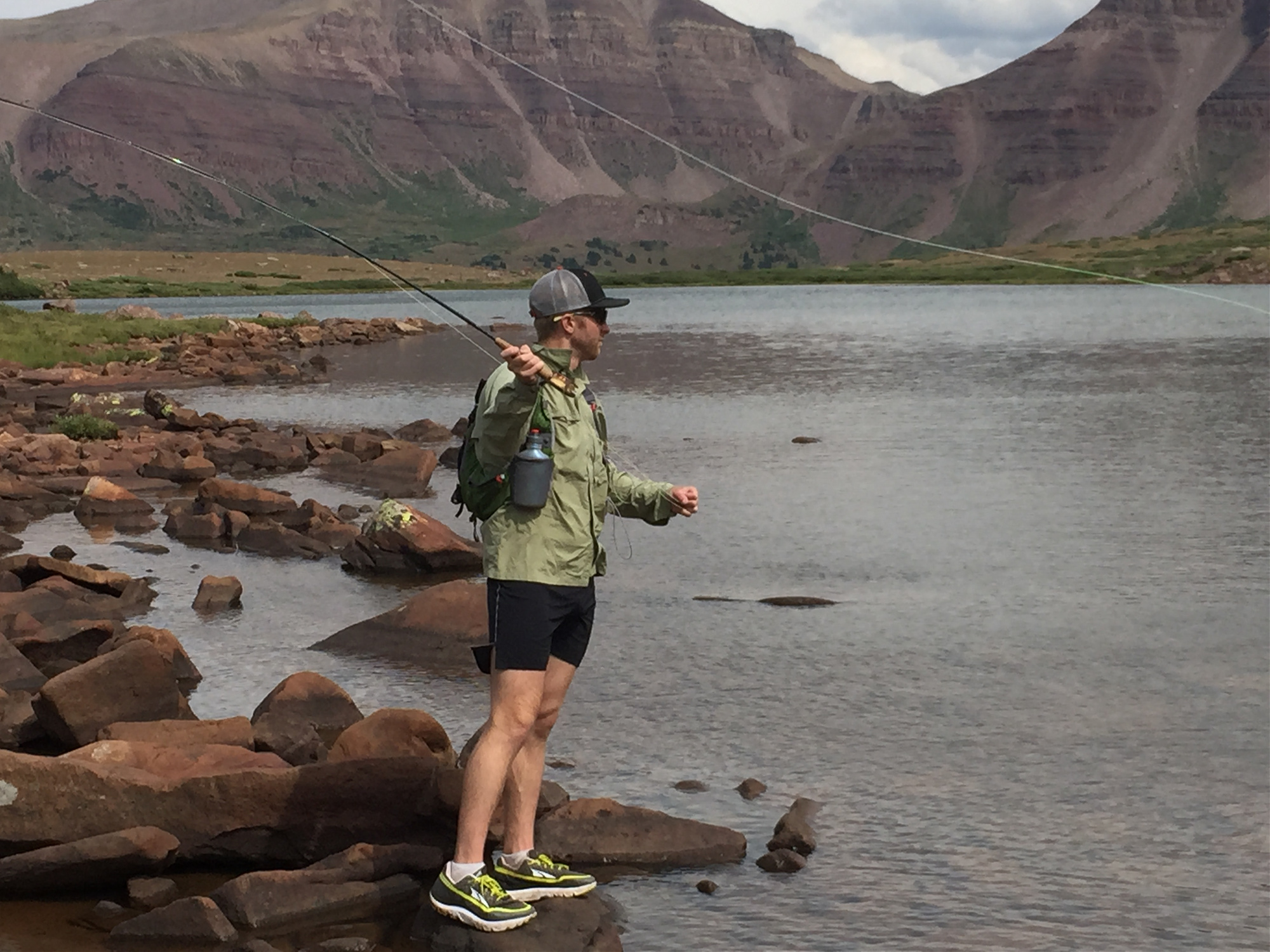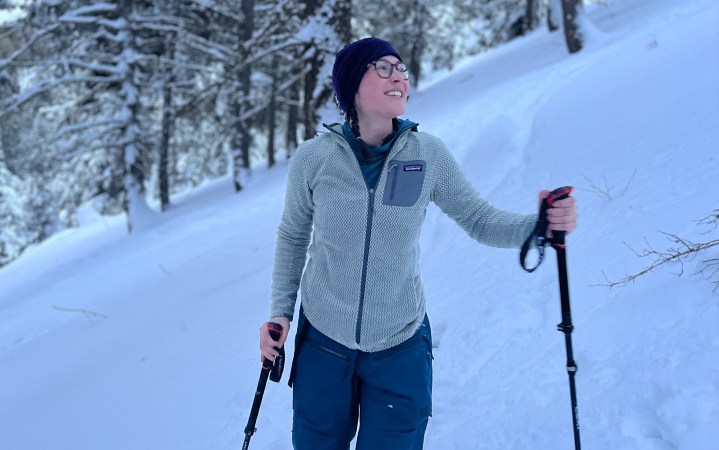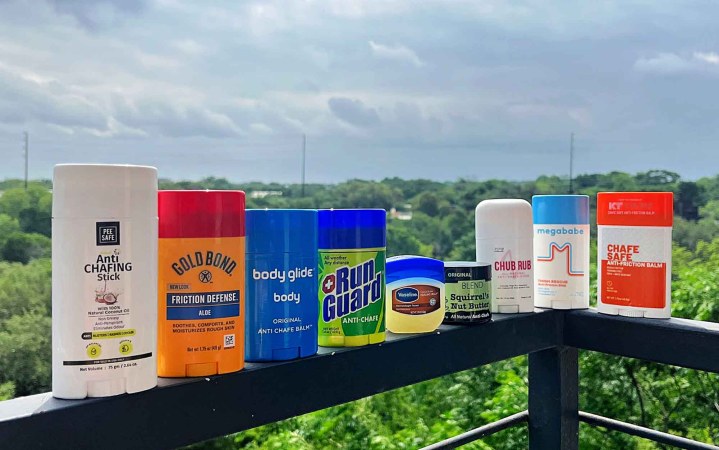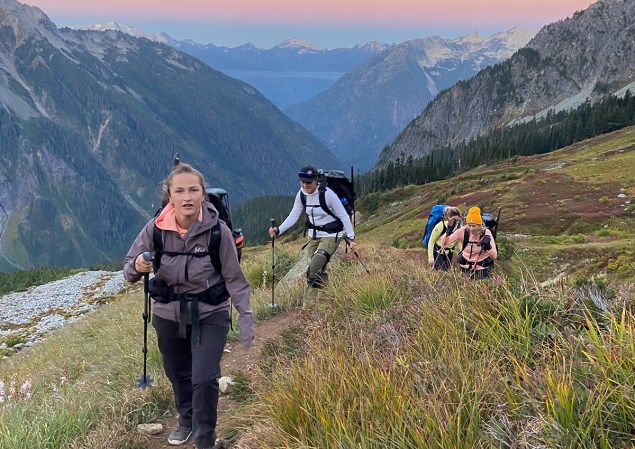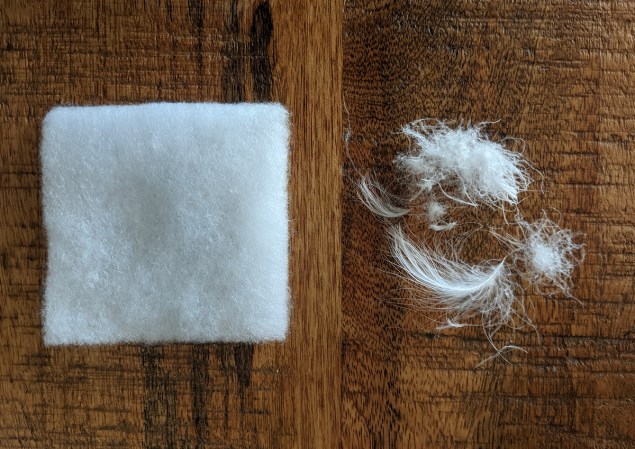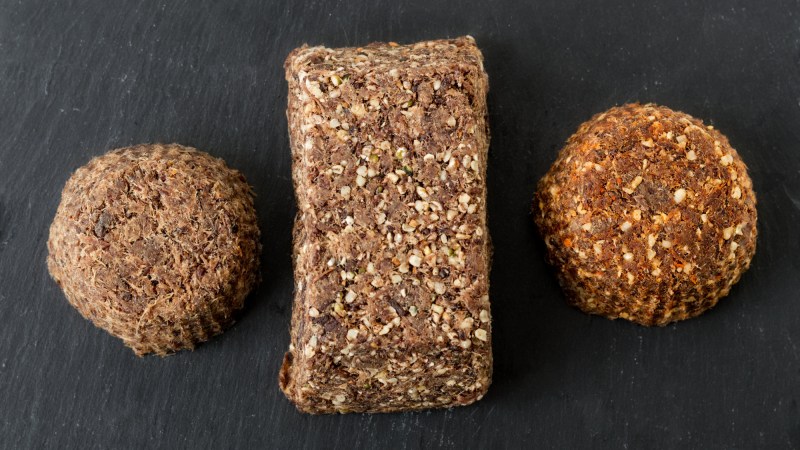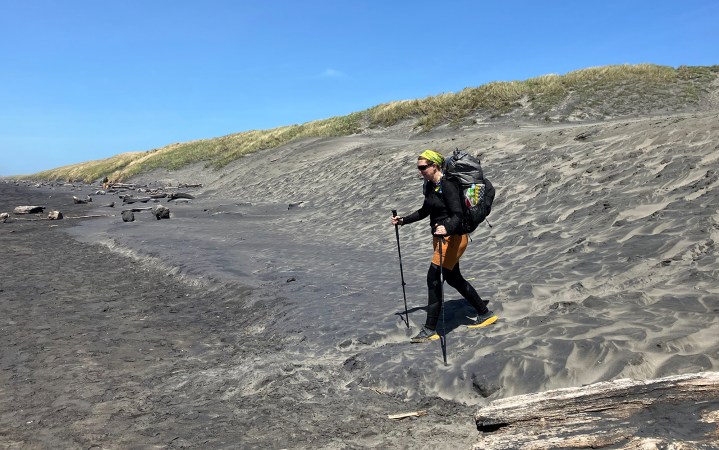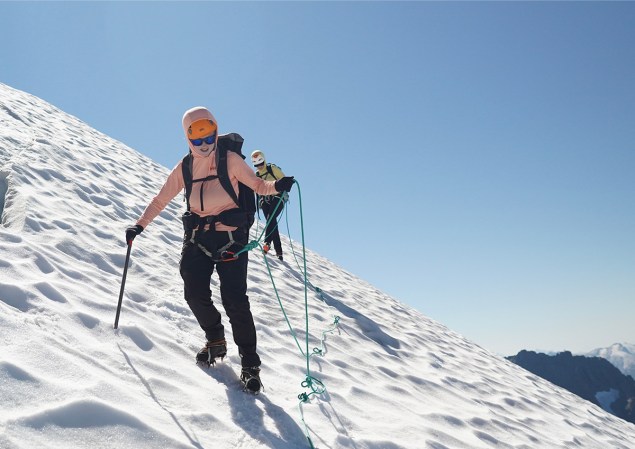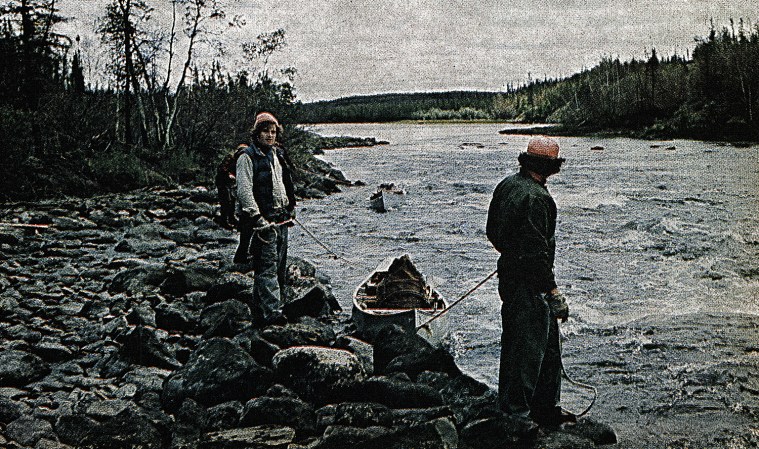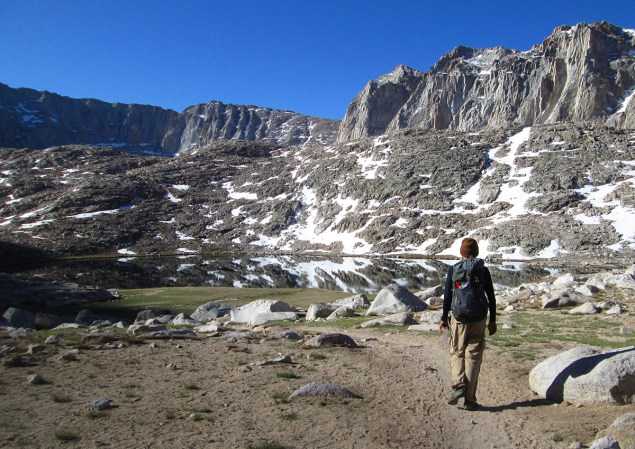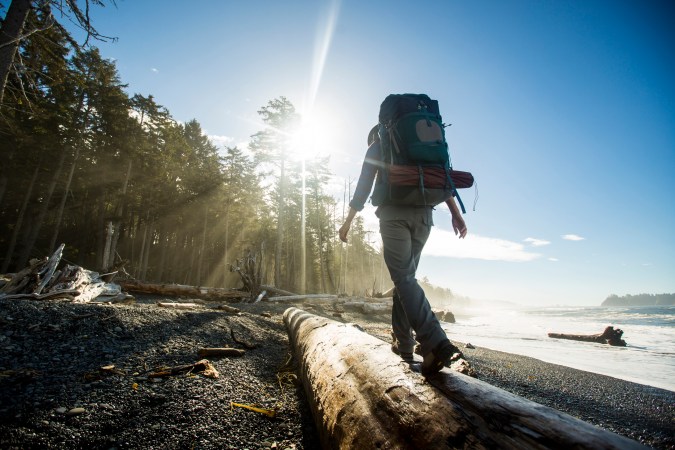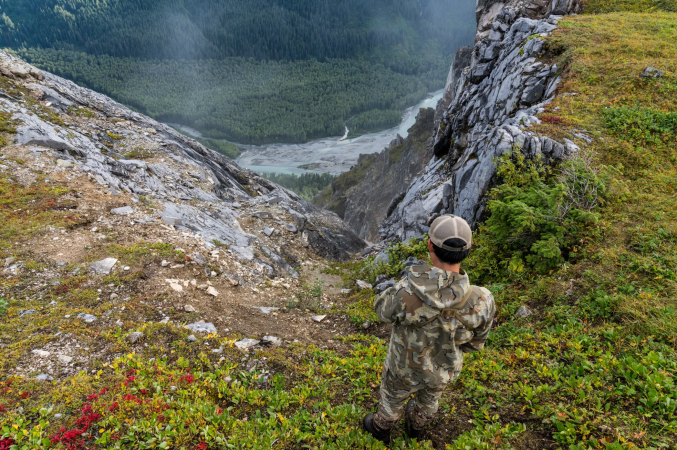We may earn revenue from the products available on this page and participate in affiliate programs. Learn More ›
There’s this place Brian Beckstead likes to go. The trailhead is an hour’s drive from Beckstead’s house in Heber City, Utah. From there, it’s 12 miles and one huge mountain pass of rough country to a cluster of alpine lakes full of non-pressured fish. Each lake is a mile from the next; all in, the loop is roughly 25 miles long — just barely shorter than a marathon. It would take any normal angler two days at least to hike that ground, probably three if they wanted to get decent sleep and fish for more than an hour or two.
But Beckstead does the whole thing in a day. He’s part of a burgeoning crowd of anglers who are shortening their gear list, lacing up their trail running shoes, and jogging to their favorite fishing spots. This blend of trail running and fly fishing, which Beckstead calls “ultra fishing,” seems simple on the surface. And it is — but that doesn’t mean it’s easy.
Ultra fishing is fun to Beckstead, but it also solves a problem that all too many outdoorswomen and men face: time constraints. Beckstead knows the demands of adulthood and the benefits of multitasking all too well. Not only is he a husband and father of three, but he’s also the co-founder of one of the most popular running shoe brands in North America. (Altra has appealed to scores of runners with its foot-shaped toe box pioneered by Beckstead and his business partner, who melted running shoes in his toaster oven for a better fit.)
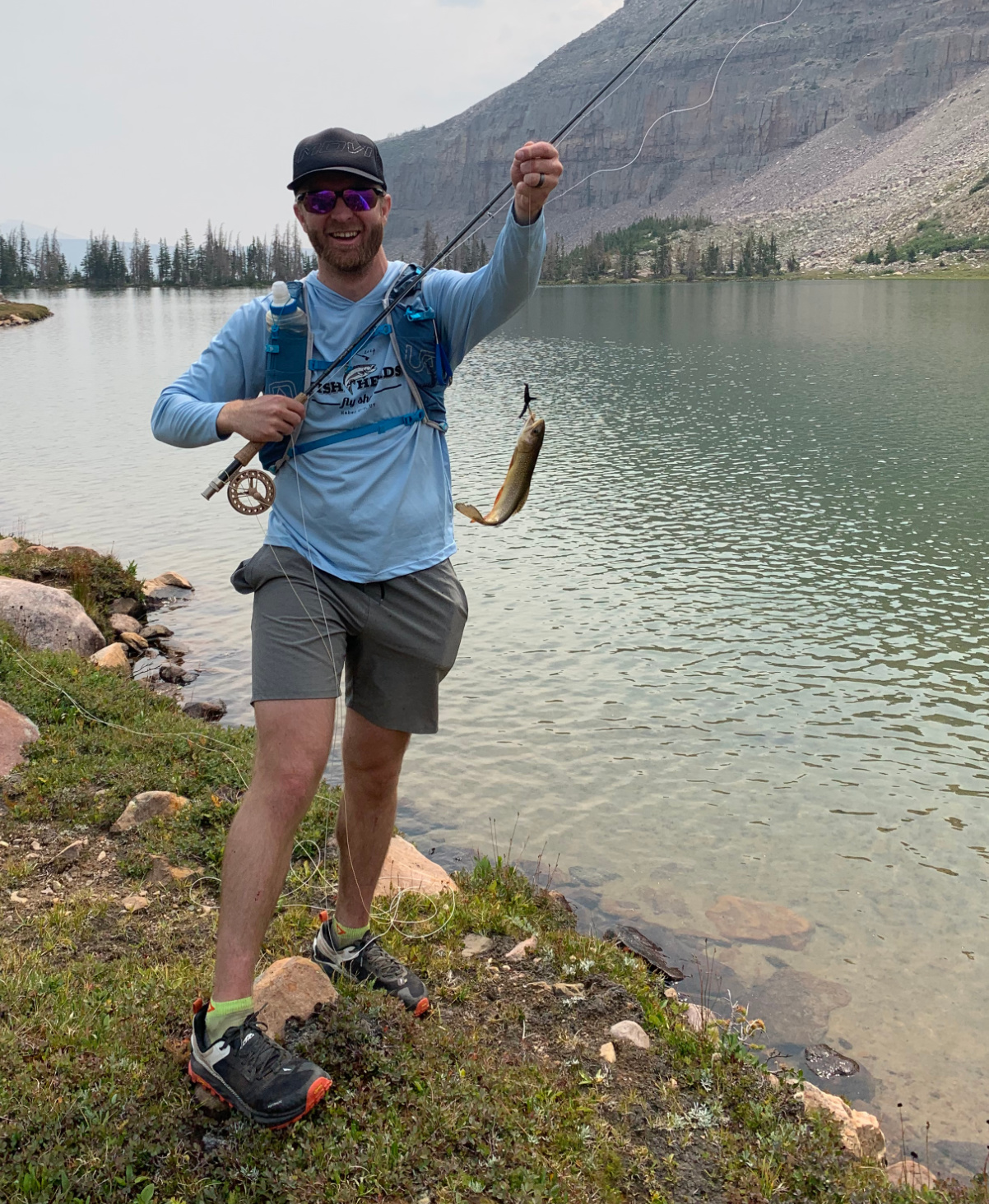
Courtesy of Brian Beckstead
We sat down with Beckstead to talk about all-things ultra fishing. Here’s his advice on how to pull it off, what tackle to pack, how to scale your fishing trips for runability, and why minimizing your tackle might help you enjoy fishing even more.
Outdoor Life: When — or more importantly why — did you start ultra fishing?
Brian Beckstead: Life started getting really busy in 2010. With my first child being born and me having absolutely no money, I didn’t have time to train for my ultramarathons, start a shoe company, go on five-day backpacking trips, and go fly fishing. So one day, I decided I could pack my fishing gear in this little running pack and go for a big run to fish. It was awesome. I think I ended up doing like 25 miles in the mountains and I caught something like 40 fish.
Golden and I had hiked the John Muir Trail in 2008, so I was no stranger to ultralight backpacking and ultra running. At that point I had already done several 100-mile trail races. I just hadn’t combined all my hobbies yet. Then in 2010 I didn’t have any time to do all these activities on their own, so I just put everything in my running pack and went for it. That’s when I coined the term “ultra fishing,” basically training for my ultramarathons and getting a little fishing in the middle of it. It was really a fun, organic thing that happened. I found other people who had done something similar, and I don’t know who came up with the idea first — it doesn’t really matter — but now there are several of us who like to do it. There’s even a race in Colorado called the Flyathlon.
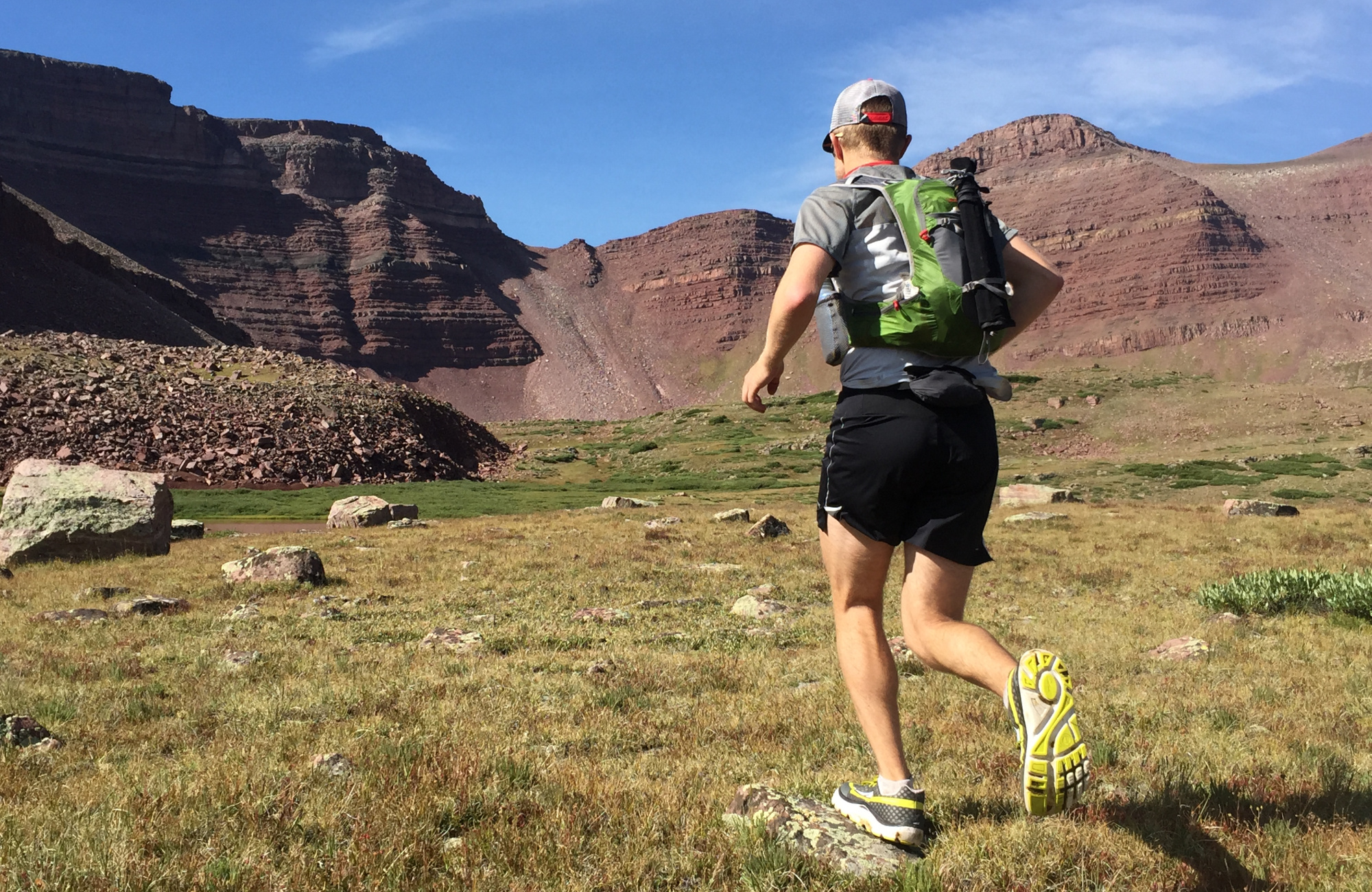
Courtesy of Brian Beckstead
OL: Walk us through a day of ultra fishing.
BB: I am very lucky because I have great access where I live. Within 60 minutes, I can be at trailheads with access to these fishing areas. For some of my longer trips, I’ll drive up and camp at the trailhead the night before. I’ll wake at the crack of dawn and start running in. You can take your time, run, walk, do a few creek crossings. I’m able to pound out the 12 miles of my favorite route in around three hours, maybe four if you’re going slower or doing more hiking.
I’ll get to the first lake around 10 or 11 a.m., and the first thing I always do is eat. You have to make sure you keep your calorie intake. You don’t want to bonk, or end up in a calorie deficit, on the way out. So I sit there, eat, and watch the lake. A lot of these high-mountain lakes have fish that cruise really close to shore. So as I’m eating my food and setting up my rod, I’m watching the lake and seeing what’s rising and where the fish are. Usually they’re easy to spot. I plan out what I’m going to use, and then I’ll usually just walk around a lake with my whole running pack on. Depending on the route and the lakes I go to, sometimes I have two hours to fish, sometimes I have four or five hours.
Read Next: A Trail Running Guide for Beginners
Then it’s a matter of how much food I have left and how much time it’s going to take me to get back. I leave plenty of time to get out before it gets dark, and in July or August, it stays light late. I’ll start running at around 2 p.m. and I’m back at the trailhead after three or four hours of running. I get down to the local burger joint and have a beer by 7 p.m.
OL: Most anglers cannot run 25 miles in a day, and have no intention of ever attempting it. What advice do you have for them?
BB: Ultra fishing is totally scalable. You don’t even need to run. You can hike 3 miles in and 3 miles out. The running aspect is just a matter of distance and time. When I go on my trips, I often pass lots of lakes on my way to my favorite spots. Obviously, the farther in you get, the better the fishing tends to be. But you can absolutely run 3, 4, 5 miles in, fish, and turn around.
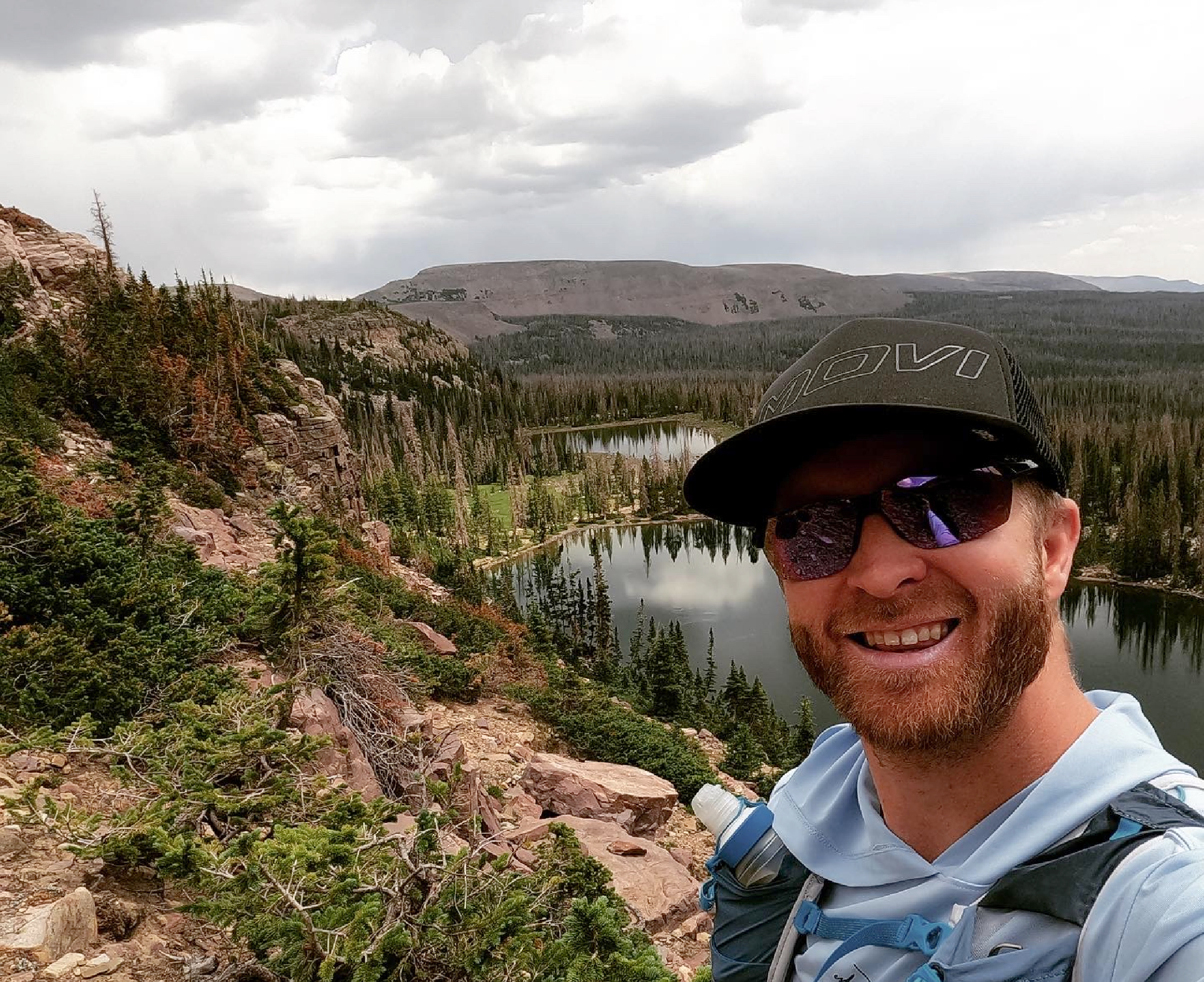
Courtesy of Brian Beckstead
OL: Let’s talk gear. What kind of setup do you fit in a running vest?
BB: Nowadays a lot of people use tenkara telescoping fly rods. I don’t love the tenkara rods, so I got an this 8-piece fly rod instead, which breaks down to be smaller than a trekking pole. I just happened to find one from a brand called Echo on a random Google search. I like a 3-, 4-, or 5-weight. And these trail running packs I use, Ultraspire, allow you to connect and carry trekking poles on them. But instead of trekking poles, I attach my fly rod. I bought a tiny click reel from Echo, and it weighs around 3 ounces. I use a shortened line setup and take about a dozen flies, a little line, a little tippet, and some hemostats. You don’t need much.
I also carry waterproof rain pants, a waterproof jacket, an emergency blanket, a small first-aid kit, and the Katadyn BeFree water filter. So I just bring one water bottle and enough food for a long run. And I always take my phone and recently started taking a Garmin inReach Mini.
OL: What about footwear?
BB: These fish are not picky, so you don’t have to wade out. I’m not getting wet. I’m just staying on the rocks and fishing around. One pair of running shoes and one pair of socks. (I’m partial to the Altra Lone Peak. That’s the shoe I made for me, for running 100-mile races and doing these types of things, but any good, sturdy trail shoe works great for this.) You can’t keep your feet dry all the time, so get a good pair of moisture-wicking socks. And if your feet get wet, so be it. That’s part of the game.
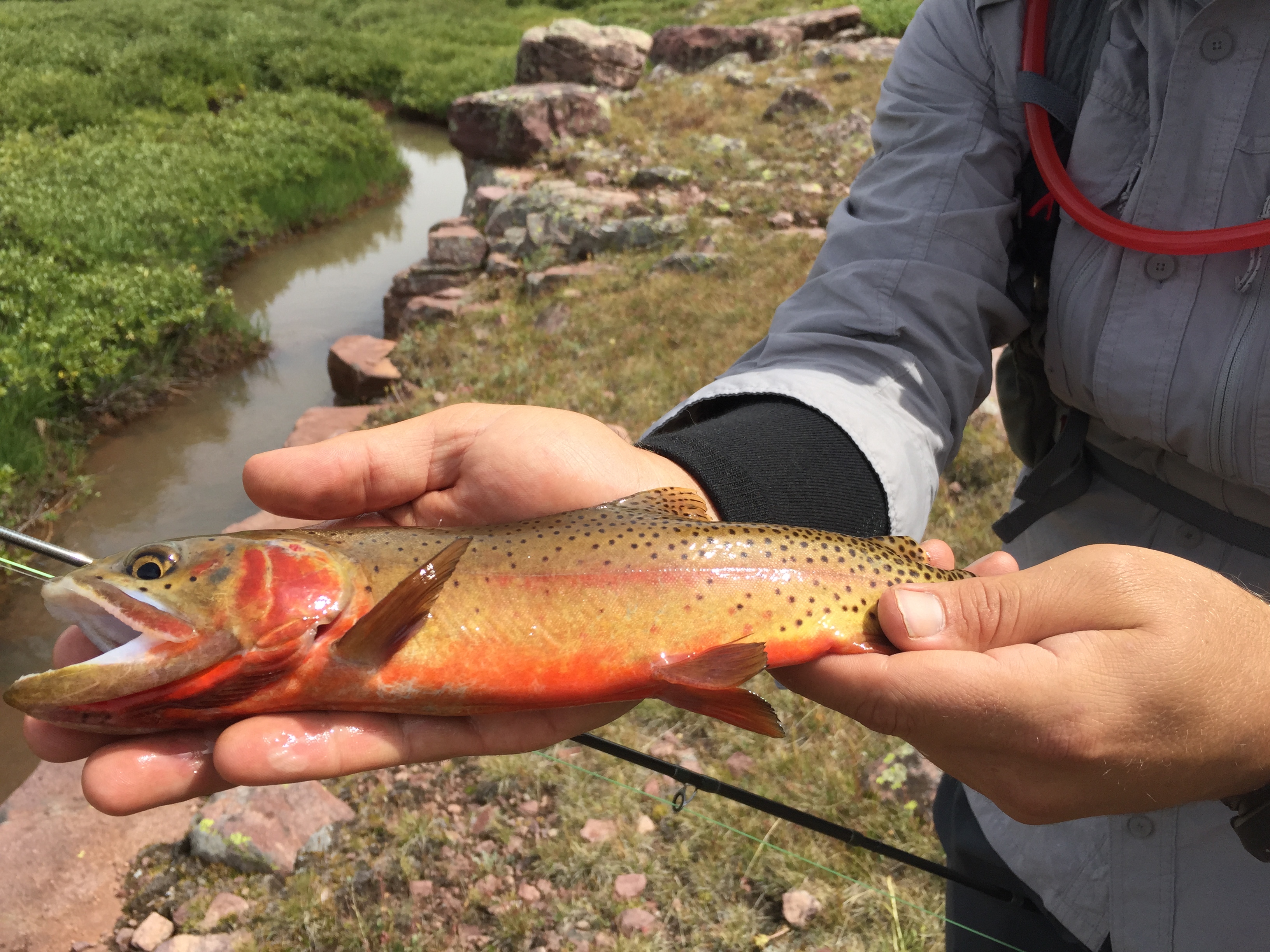
OL: We live in this era of gear maximization in how we recreate outdoors. The gear industry is churning out new products, new must-haves all the time. Is only bringing what you can fit in a running pack your way of rebelling?
BB: It’s funny you mention that. I’ve been in the gear industry my whole life. I started working at a running store, then I worked in a ski and outdoor shop in college. I get the gear nerds. I understand them. So I don’t know if this is so much an act of rebellion, but over the years, I’m starting to feel like I just don’t need all that stuff. I’ve become much more of a minimalist. I’ve done a lot of fast-packing and I like the ultralight gear, and I think one of the reasons I like that gear is because I find it more simple, which is really more my style. I like clean, simple products that work. When I’m up in the mountains, being self-sufficient and smart and traveling light is important to me both in terms of my footprint — I don’t have gear dangling off my pack, I don’t want to litter — and because it feels really primal and natural.
OL: Any tips for beginners?
BB: Take what you need to be safe and comfortable. It’s great to be minimal and go crazy, but for a novice, you have to start in a safe area. Take a little more gear than you might otherwise, and then learn from those experiences. I should put all this in context — I’m a National Outdoor Leadership School graduate, a wilderness first responder, I have a degree in exercise science and outdoor recreation management, I’ve been a backpacking instructor, and I’ve run nearly 70 ultramarathons, so I know what I need and don’t need.
OL: Tell us about one of your favorite ultra fishing trips.
BB: Well, it’s not even an ultra fishing experience, but it’s an example of the hybrid trip we mentioned for beginners. I was finally able to take my entire family on that 25-mile loop this past summer. We did 6 miles on the first day, 6 miles on the second, then we spent a layover day in the mountains exploring those lakes, and then we did the whole 12 miles out. Being able to do it in four days and take my children was really special. My daughter was nine years old and carried her own backpack and sleeping bag. My 13-year-old son had his first 100-fish day up there. So, came full-circle and that was pretty awesome.
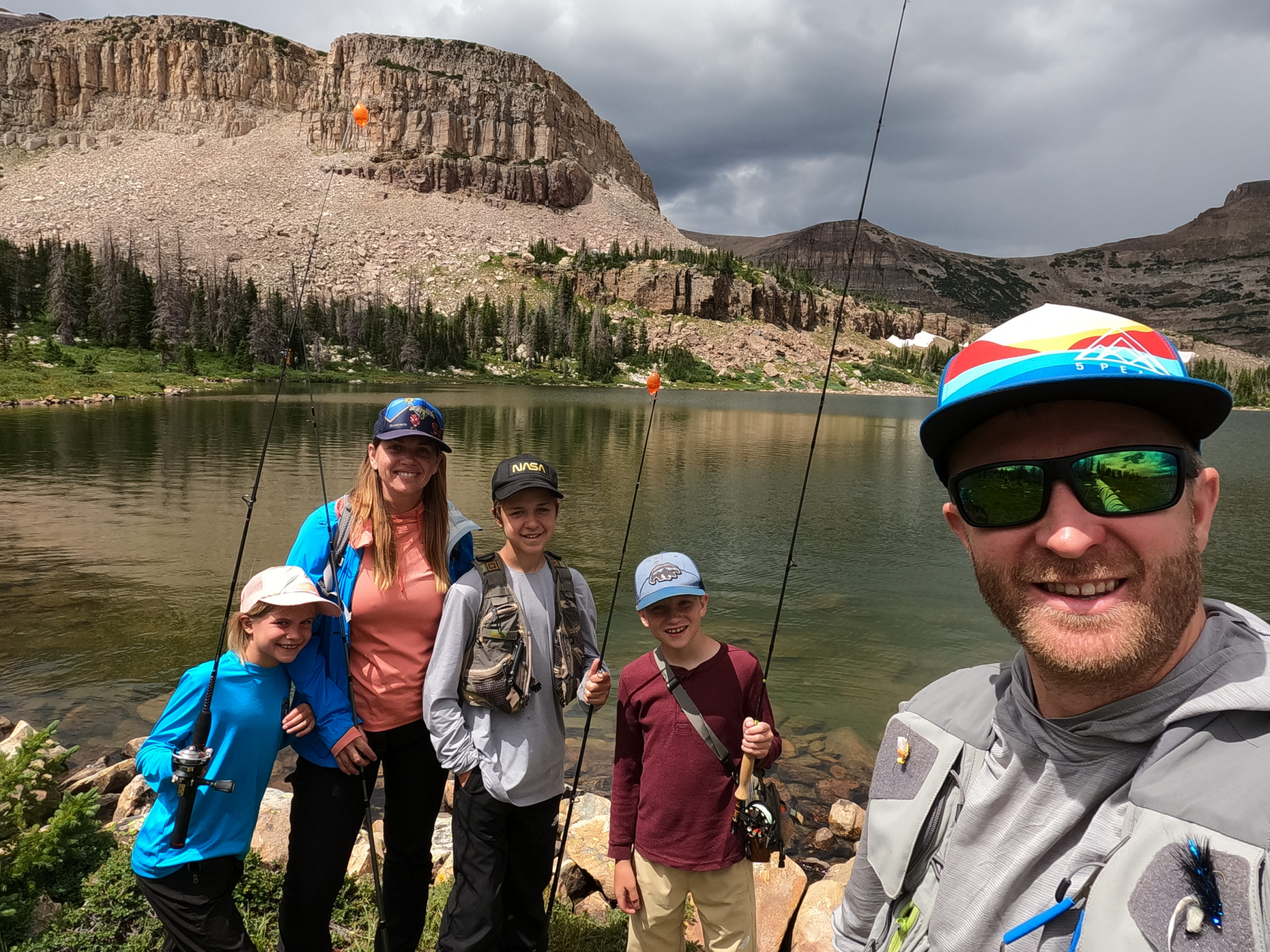
Courtesy of Brian Beckstead
OL: When can we expect to see a zero-drop wading boot from Altra?
BB: Oh boy, I would love to do that. No wading boots from Altra any time soon, I don’t think we’re going to delve into that, but as I’ve gotten older I’m doing less running and fishing more. I do fish year-round and I’m not just ultra fishing, I do go fish in a lot of crazy wilderness, and I actually started another little company called Payara Fly Fishing. So as much as I love combining those two wonderful hobbies, doing them separately is wonderful, too.

